4 Ocular Trauma
Many eyes that are enucleated have a past history of nonsurgical or surgical trauma. The eye can be totally destroyed by severe injuries that violate the integrity of its protective coats and scatter its contents. Less devastating injuries cause blindness by disrupting the normal anatomical and functional relationships between the eye’s highly specialized tissues. Retinal detachment, retinal avulsion anteriorly from the ora serrata or posteriorly from the optic nerve, avulsion of the optic nerve from the globe, iridodialysis or cyclodialysis, lens dislocation, and choroidal rupture are examples. By disrupting pristine anatomical relationships, trauma also exposes new surfaces that cells can proliferate on. These include the inner and outer surfaces of the retina after retinal detachment, the posterior face of the vitreous exposed by vitreous detachment, or anterior chamber structures made accessible to surface epithelium by poorly apposed wounds in the cornea. Cellular proliferation on these newly exposed surfaces leads to permanent adhesions between structures, membrane formation, fibrosis, traction, retinal detachment, and glaucoma. Hemorrhage commonly complicates trauma. The blood opacifies transparent ocular media such as the vitreous and may cause secondary glaucoma by occluding aqueous outflow pathways. In addition, intraocular hemorrhage causes expulsion and irrevocable loss of vital intraocular structures when it accumulates in the suprauveal space and fills the interior of the eye (expulsive choroidal hemorrhage). Blindness also can result when the body’s normal mechanisms of regeneration and repair cause scarring that affects highly differentiated transparent tissues or when fibrous membranes exert traction on vital structures. For example, the fibrous organization of tracts of hemorrhage in the vitreous left by perforating missiles ultimately can cause tractional retinal detachment. Trauma also predisposes to infection by destroying the eye’s normal protective barriers. Infection is always a danger after ocular trauma, even minor injuries such as corneal abrasions. Organisms introduced by penetrating injuries or contaminated intraocular foreign bodies of metallic, vegetable, or even endogenous animal (e.g., hair, skin) composition can cause exogenous endophthalmitis.
The terms penetrating and perforating are commonly applied to ocular injuries that produce defects in the integrity of the ocular coats. A penetrating injury partially cuts or tears a structure. A perforation is a through-and-through injury that completely cuts or tears through a structure (Fig. 4-1). To use these terms properly, one must specify the structure that is involved. For example, a corneal laceration is both a perforating injury of the cornea and a penetrating injury of the globe. Most corneal foreign bodies produce a small penetrating injury in the anterior stroma that is filled by the corneal epithelium forming an epithelial facette (Fig. 4-2A).
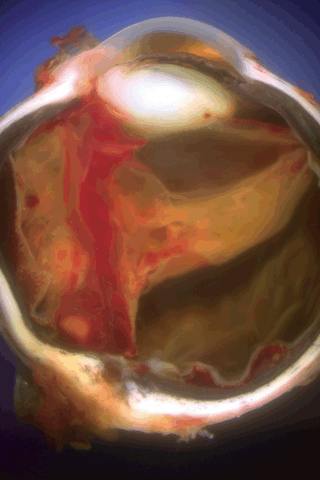
Fig. 4-1. Perforating injury of globe. Ocular perforation caused by BB gun is a through-and-through injury with entrance and exit wounds in limbus and sclera, respectively. The track of the BB is marked by fresh blood. Posteriorly detached vitreous also contains ochre-colored degenerated blood.
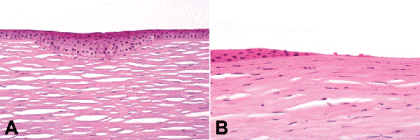
Fig. 4-2. A. Epithelial facette, cornea. The epithelium fills crater in Bowman membrane and anterior stroma caused by corneal foreign body. B. Corneal abrasion. The sliding epithelium healing the corneal abrasion has tapering margin. (A. Hematoxylin-eosin [H&E] ×100, B. H&E ×100.)
The ophthalmic pathology laboratory frequently processes eyes that have been ruptured by severe blunt trauma, have severe corneoscleral lacerations caused by sharp objects, or have been perforated by missiles such as BBs (Fig. 4-3). Pathologic examination of some severely traumatized eyes reveals a disrupted scleral shell filled with blood and scant remnants of intraocular tissue. Most cases show intraocular hemorrhage and loss or incarceration of intraocular structures. Massive intraocular hemorrhage typically involves the vitreous, and subretinal and suprauveal spaces. Loss of intraocular contents is caused by the space-occupying effect of expanding suprauveal hemorrhage and compression of the eye by the surrounding orbital tissue and forceful eyelid closure. Both mechanisms elevate the intraocular pressure (IOP) and expel the intraocular tissues through the open wound. Tissues that frequently are lost or incarcerated in the wound include the iris, lens, ciliary body, vitreous, and occasionally the retina and choroid. Prolapsed intraocular tissue excised during the repair of corneoscleral lacerations should always be submitted for pathologic examination. If retina is found, the prognosis is poor.
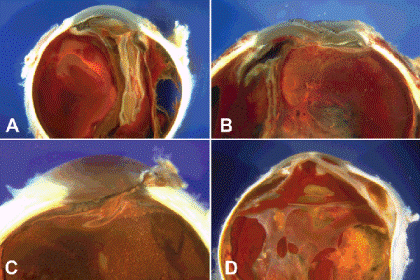
Fig. 4-3. A. Ruptured globe. Lens and detached retinal are incarcerated in sutured limbal wound. The anterior chamber is flat and part of the iris is absent. A massive suprauveal hemorrhage fills half of the posterior segment. B. Corneal laceration. A sutured laceration is present in the central cornea. The lens and half of the iris are absent, and the detached retina is drawn toward the wound. Most of the blood filling the interior of the eye is located in the suprauveal space. C. Uveal and retinal incarceration in limbal wound. Pigmented uveal tissue and orange band of detached retina extend extraocularly through scleral wound. Degenerated blood fills the interior of the globe. D. Old ruptured globe. Organized vitreous is incarcerated in the central corneal scar. Anterior uvea and lens are absent.
Expulsive choroidal hemorrhage caused by an expanding suprauveal hematoma is a dreaded complication of ocular surgery. Intraoperative rupture of a sclerotic arteriole caused by the sudden hypotony of surgery causes the expanding hemorrhage in the suprachoroidal space. Spontaneous expulsive choroidal hemorrhage can also complicate corneal perforation in glaucomatous eyes (Fig. 4-4).
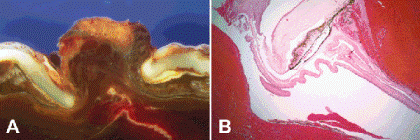
Fig. 4-4. Spontaneous expulsive hemorrhage. A. A knuckle of uveal tissue is expelled extraocularly through lips of gaping perforation in the infected cornea by massive suprauveal hemorrhage. A hypopyon fills the residual anterior chamber. B. Detached retina and hemorrhagic detachment of choroid extend extraocularly through perforation in infected cornea. Blood detaches the ciliary body at right. Neovascular glaucoma predisposed to acute keratitis and corneal perforation. (H&E ×5.)
SYMPATHETIC UVEITIS (SYMPATHETIC OPHTHALMIA)
Expedient enucleation of eyes that are severely traumatized and hopelessly blind is strongly advised as prophylaxis against a rare autoimmune disorder called sympathetic uveitis, which affects and potentially can blind both eyes after unilateral trauma. Sympathetic uveitis (ophthalmia) is a severe bilateral granulomatous inflammation of the uveal tract that follows unilateral trauma or surgery, which usually is complicated by the incarceration of uveal tissue in the wound (Fig. 4-5). Blurred vision, photophobia, and signs of granulomatous inflammation develop in the uninjured or sympathizing eye simultaneous with exacerbation of signs and symptoms in the injured or exciting eye.
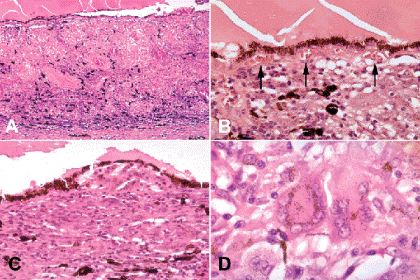
Fig. 4-5. Sympathetic uveitis. A. The choroid is massively thickened by a diffuse granulomatous infiltrate of epithelioid histiocytes, giant cells, and lymphocytes. B. Sparing of the choriocapillaris. Arrows denote persistent choriocapillaris beneath Bruch membrane and the RPE. C. Dalen-Fuchs nodule, sympathetic uveitis. Aggregate of epithelioid histiocytes on the inner surface of Bruch membrane focally detaches RPE. Underlying choroid contains diffuse granulomatous inflammatory infiltrate rich in epithelioid histiocytes. D. Giant cells in choroidal infiltrate contain granules of melanin pigment. (A. H&E ×25, B. H&E ×100, C. H&E ×100, D. H&E ×250.)
Sympathetic uveitis is thought to be a T-cell–mediated autoimmune response to uveal or retinal antigens released by the injury. Uveal pigment, retinal S antigen, and interphotoreceptor retinoid–binding protein could be possible antigens. Sympathetic uveitis occurs between 2 weeks and 1 year postinjury in about 90% of cases, most cases occurring during the 3-week to 3-month interval. Sympathetic uveitis generally will not develop if the injured eye is enucleated within 1 week of the injury. If enucleation of the injured eye is delayed, the noninjured eye still remains at risk. There is some evidence that enucleation of the inciting eye decreases the severity of the inflammation in the sympathizing eye after bilateral uveitis develops. Rare cases of sympathetic uveitis have been reported after ocular evisceration. These probably are related to antigenic material left behind in scleral emissarial canals, which typically are involved by granulomatous inflammation.
Sympathetic uveitis is a clinicopathologic diagnosis. There must be a history of unilateral trauma followed by bilateral uveitis. Four characteristic features are found on histopathologic examination. The uvea is thickened by a diffuse granulomatous infiltrate composed of epithelioid histiocytes, inflammatory giant cells, and lymphocytes of the T-suppressor/cytotoxic subtype (Fig. 4-5A). The choriocapillaris is not destroyed by the inflammation (sparing of the choriocapillaris) (Fig. 4-5B). The epithelioid histiocytes and giant cells usually contain granules of phagocytized uveal pigment (Fig. 4-5D). Nodular aggregates of epithelioid cells, which focally detach the retinal pigment epithelium (RPE), are found on the inner surface of Bruch membrane (Fig. 4-5C). These Dalen-Fuchs nodules are not pathognomonic for sympathetic uveitis because they also occur in sarcoidosis and Vogt-Koyanagi-Harada disease. The uveal infiltrate rarely contains plasma cells. Eosinophilia may be found in deeply pigmented patients, in whom the inflammation typically is more severe. Sympathetic uveitis usually spares the retina. One should consider another diagnosis if retinal involvement is found distant from the site of injury. Although their immunopathogenic mechanisms differ, both sympathetic ophthalmia and phacoantigenic uveitis may occur concurrently in the same traumatized eye. Atypical histopathologic features occur in some cases, generally are associated with severe choroidal inflammation, and may be a response to high doses of antigenic material. Progressive subretinal fibrosis with multifocal granulomatous chorioretinitis is thought to be a variant of sympathetic ophthalmia.
Minor contusion injuries often cause abrasions of the corneal epithelium that rapidly heal by epithelial sliding (Fig. 4-2B). Severe contusion injuries can rupture the cornea and/or sclera. A rupture caused by blunt trauma can occur directly at the site of impact. In other instances, the thinnest parts of the globe such as the limbus, or the scleral behind the insertion of the rectus muscles or adjacent to the optic nerve, are involved indirectly by force vectors transmitted by the essentially incompressible globe.
Contusion injuries need not disrupt the integrity of the cornea or sclera to wreak severe intraocular havoc. Ocular contusion injuries can rupture Descemet membrane, the lens, or choroid; detach or avulse the retina from its attachments to the ora serrata (Fig. 4-6) or optic nerve; or fracture photoreceptor outer segments causing Berlin edema or commotio retinae. Late cystoid macular degeneration or macular holes are common sequelae. Other anterior segment complications include lens dislocation, contusion rosette cataract (Fig. 4-7A), postcontusion angle recession, iridodialysis, cyclodialysis, and hyphema.
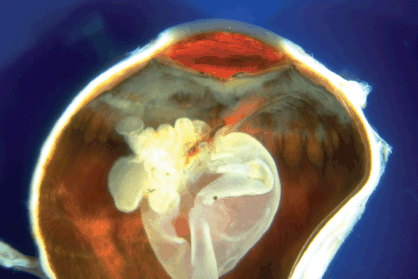
Fig. 4-6. Anterior retinal avulsion, contusion injury. The retina’s attachments to the ora serrata have been disrupted. A hyphema fills the anterior chamber.
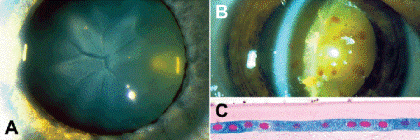
Fig. 4-7. A. Contusion rosette cataract. Petalliform configuration of traumatic cataract reflects damage to superficial lens fibers. This type of cataract serves as a clinical marker for ocular contusion injury. B. Siderotic cataract. Iron from intraocular foreign body has formed rusty deposits beneath the anterior capsule of cataractous lens. C. Prussian blue reaction highlights iron in the lens epithelium. (C. Iron stain ×100.)
Blood staining of the corneal stroma is a potential complication of chronic hyphema (Fig. 4-8). Whether corneal blood staining develops or not depends on the health of the corneal endothelium, the IOP, and the duration of the hyphema. Blood staining may occur within 48 hours if the IOP is high. The corneal stroma contains small particles of hemoglobin, not intact erythrocytes. Golden-brown granules of hemosiderin are found in the cytoplasm of the keratocytes.
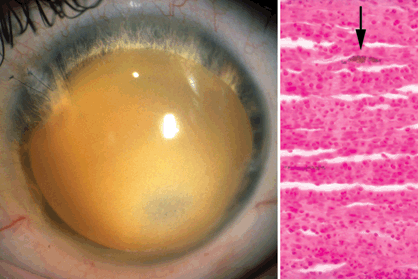
Fig. 4-8. Corneal blood staining. Central cornea is opacified by ochre deposit. Histopathology of corneal stroma discloses small particles of hemoglobin that are much smaller than intact erythrocytes. One of the keratocytes contains granules of golden-brown hemosiderin pigment (arrow). (Right panel, H&E ×250.)
During a contusion injury of the anterior segment, the lens and iris act together as a ball valve that confines the aqueous humor to the anterior chamber. The incompressible aqueous humor conveys the force of the blow to the weakest parts of the anatomy, which are subject to damage (Fig. 4-9). The iris may be ripped from the ciliary body at its root where it is very thin (iridodialysis). In other cases, the tenuous attachment of the ciliary muscle to the scleral spur is disrupted, causing detachment of the ciliary body or cyclodialysis (Fig. 4-9D).
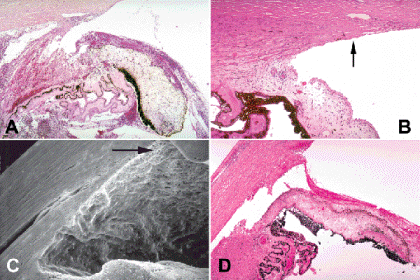
Fig. 4-9. Contusion injuries, anterior segment. A. Acute angle recession, contusion injury. Tear into the face of the ciliary body is located internal to the longitudinal part of the ciliary muscle, which remains attached to the scleral spur. A layer of blood rests on the anterior surface of the iris, which shows early necrosis. B. Postcontusion angle recession. The iris root is displaced posteriorly, markedly widening the ciliary body band. Arrow points to scleral spur. The ciliary processes are displaced posteriorly and the residual ciliary muscle has a fusiform configuration. Incidental pseudoexfoliation is present. C. Postcontusion angle recession. Arrow in SEM denotes trabecular meshwork. The iris root is displaced posteriorly, widening the ciliary body band. The ciliary muscle is fusiform in shape. D. Cyclodialysis, contusion injury. The ciliary body has been avulsed from its attachment to the scleral spur. The iris shows early necrosis. A hyphema is present. (A. H&E ×25, B. H&E ×50, C. SEM ×40, D. H&E ×25.)
Stay updated, free articles. Join our Telegram channel

Full access? Get Clinical Tree


